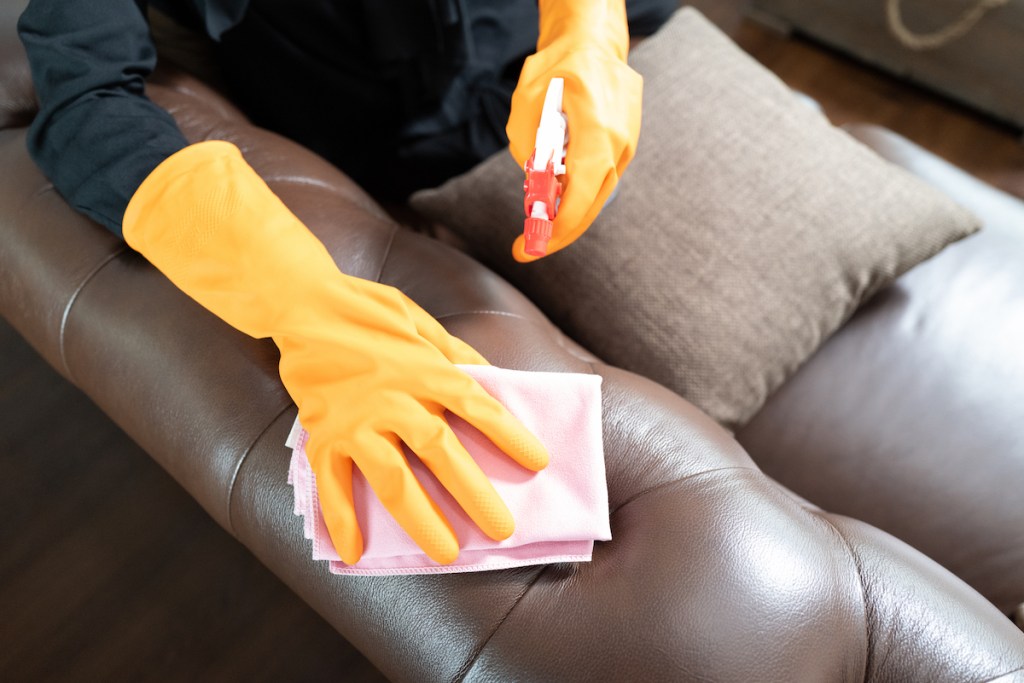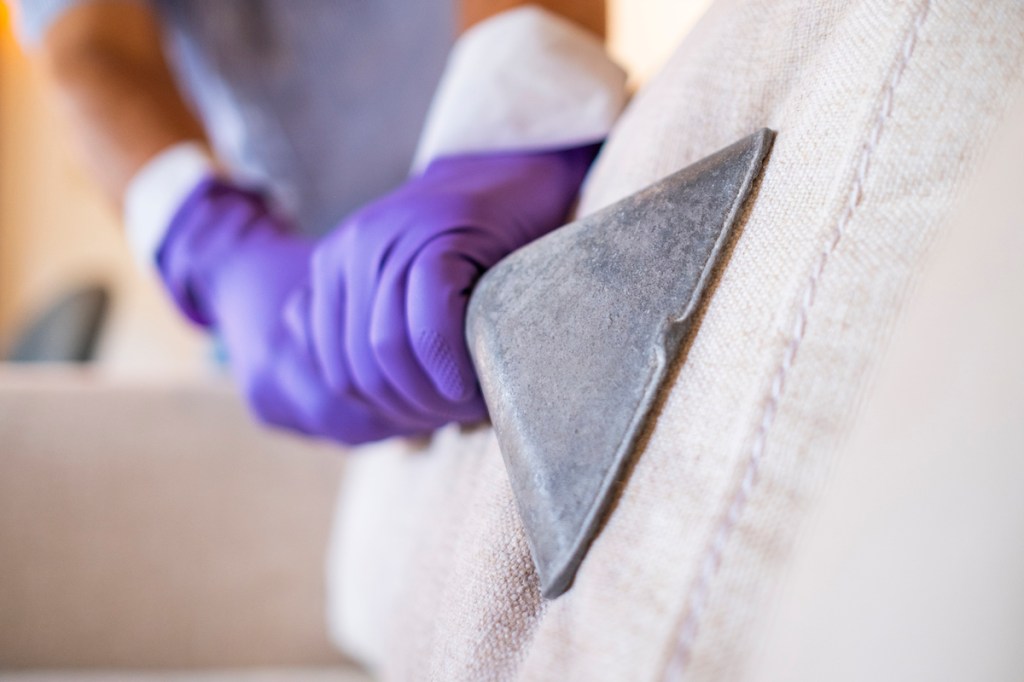How To Deep Clean a Couch: Expert Tips for Getting It To Look Like New
You can even try a hairdryer hack or a homemade cleaning solution!

A couch is the anchor of your living room, and yet it’s easy to take it for granted. We may sit on the couch every day (and even nap there!), but how often do we really take the time to make it look its best? Sure, we can put on some nice throw pillows or spot-clean when we spill something, but when it comes to doing a deep-clean, our couches probably aren’t on the top of the list.
It’s hard to even know where to start cleaning a couch. Should we vacuum it? Take the cushions and slipcover off? What cleaners should we even be using? There are also many different types of couches out there, from sleek black leather ones to upholstered cotton ones in charming prints, so it’s tricky to determine the best cleaning strategy. Thankfully, there are some smart tips that will help make your couch look as lovely as it did the day you bought it. We spoke to a variety of cleaning pros to get the scoop on how to deep clean a couch.
Start with the tag
“When deciding how to clean upholstered furniture, always start by checking the care instructions,” says Mary Gagliardi (aka “Dr. Laundry”), in-house scientist and cleaning expert for Clorox. The care tag is easy to overlook (maybe you didn’t even realize your couch had one!) and it’s usually found under the cushions.
The care symbols for upholstery typically include:
- W: Water-based cleaning solution
- S: Solvent-based cleaning solution
- W/S: Water or Solvents can be used
- X: No cleaning other than vacuuming is allowed.
Marica Dacey, a third-generation cleaning pro with Amodex, notes that even if you look at the tag first, it’s still best to pull a cushion out and test whatever product you’re using in an unseen corner first to make sure it works.
How to clean a suede or leather couch
Leather and suede couches can be the most intimidating to clean. “Leather is so absorptive,” says Dacey. “You might think a little stain is a little stain, but it really soaks it up like a sponge, which makes it take longer to clean,” she adds. Patience is key: “You need to let the cleaning solution sit longer on leather than on other fabrics in order to undo the fusion between the stain and the fabric.”

Some brands make leather-cleaning wipes that are “convenient to use and work to clean and moisturize finished leather just by wiping the surface,” says Gagliardi. However, before you use the wipes, “be sure to vacuum the couch first, and then dust all surfaces with a barely-damp microfiber cloth,” she notes.
Gagliardi says that while natural suede typically requires professional cleaning and should not be treated with water or cleaning solutions, synthetic suede like ultrasuede and microsuede “can usually be spot cleaned with some water-based cleaning solutions as long as you test the product you want to use.” After treating a synthetic suede couch, “the fabric will likely need to be brushed to restore the fibers,” she notes.
Another thing to keep in mind? “With leather and synthetic suede couches, it can often look like a water stain develops after the stain is removed,” says Dacey. This may cause you to panic, thinking you’ve made a stain worse, but Dacey has a clever hack for keeping things under control. “Have a hairdryer handy while you’re cleaning and rinsing it,” she says. “Keep it on a cool or lukewarm setting and as the couch is damp to touch, use the dryer on the suede or leather. This will prevent a water stain from developing or make it go away.” This hairdryer trick even works on delicate fabrics like silk!
How to clean a cloth or microfiber couch
“With cloth and microfiber, the weave of the fabric is wider and bigger than leather or suede,” which makes these couches easier to clean than leather or suede ones, says Dacey. “Microfiber and cloth are designed to take a beating,” she adds. Dacey likes using a home upholstery cleaner machine on her own couch, but acknowledges that they can be pricey. If you do have one of these machines, it can help you deep-clean more effectively, but if you don’t, you’ll just want to be as patient as possible. “Some cleaners will have to sit for an hour or two before rinsing, especially if you’re dealing with a heavier stain,” she notes.

You’ll also usually want to vacuum your cloth or microfiber couch using the upholstery attachment on your vacuum, says Gagliardi. “Cloth or fabric upholstered couches labeled ‘W’ or ‘W/S,’ including microfiber couches, can usually also be spot treated with a water-based cleaning solution,” she notes. For smaller or newer stains, “spray your cleaning solution directly onto the stain and let stand for 3 minutes. Next, blot with a damp cotton washcloth to rinse, then blot again with a clean, dry, cotton washcloth to remove moisture,” she says. She notes that products with hydrogen peroxide are particularly effective here.
How to clean couch cushions
“For couch cushions, if you can remove them, spot clean them and throw the slipcovers in the wash, that is the route you want to take,” says Dacey. She cautions that “Sometimes the fabrics become very rigid as they dry, so if you try to stuff the cushion back in, you can’t zip it shut.” This can be frustrating, but she has a good way to avoid it: “put the pillows back together while they’re still slightly damp,” she says. “That little extra wetness gives the fabric a malleability that it wouldn’t have when it’s dry and makes the process of putting the cushions back together so much easier.” You also don’t need to clean the cushions themselves unless there’s a major stain. “The fabric of the slipcover tends to absorb everything before it gets to the cushion itself,” she says.
Gagliardi says that you should try to clean the different parts of your couch consistently — you don’t want one part of your couch to end up clean and crisp while another part remains dingy! As she explains, “if you use an upholstery attachment on a steam cleaner to clean the couch body, do the same for the cushions.” Once the cushions have been cleaned, “prop them upright on their sides away from the couch on a clean towel while they air dry,” she says. “This allows greater air circulation to help speed up drying time.”
If you want to save time on cleaning your couch cushions, Gagliardi also notes that some fabric slipcovers can even be machine-washed!
How often to clean a couch
The best part of all this? You don’t even need to deep-clean your couch that often! While how often you clean your couch depends on personal preference and whether you have kids or pets, even the pros don’t do it as often as you think. “I should probably be deep-cleaning the couch more often,” Gagliardi admits, “But with regular vacuuming and spot-cleaning, I buy myself more time between deep-cleanings and always have a guest-ready couch!” Similarly, Dacey says she only does a deep-cleaning about once a year. “You’d be surprised how you don’t have to do the big cleans if you’re on top of the smaller ones,” she says.

Two couch-cleaning recipes
If you’re not sure of the best approach for couch-cleaning, you might want to try an all-purpose homemade cleaning formula. Laurie Fulford, laundry pro with Poplin, has you covered. “I’d recommend the same two ‘recipes’ for cleaning faux suede, cloth and microfiber couches,” she says.
“The first mixture is simply a half a cup of white vinegar, mixed with a cup of warm water,” she explains. “Use a sponge to dab and clean the stain.”
“The second mixture is a pinch of baking soda, a small amount of water and a small squeeze of mild dish soap,” she says. “The goal is to make this into a paste that you can spread on the stain. Let it sit for 5 to 10 minutes and then wipe away with a damp washcloth.”
You likely already have everything you need to make these cleaning solutions, and Fulford says they work many different types of couches. You can use them on fabric couch cushions too. “Fill your bathtub with warm, soapy water and submerge the cushions once the water is filled,” she says. “Massage the cushions to get the soapy mixture distributed. Rinse the cushions well, wrap in towels to absorb as much water as possible and then let air dry.” Who knew there were such easy recipes for cleaning your couch?
“Some people say cleaning couches is something you need to outsource,” says Dacey. She acknowledges that “It can be intimidating, but if you follow some rules to start, the process will be so much easier.” With the pro tips for how to deep clean a couch above, getting it to look spiffy will be simpler than you ever thought possible!
Find furniture cleaning hacks here:
The ‘Iron’ Secret To Removing Red Wine Stains From Upholstered Furniture
How to Clean Wicker Furniture: Experts Reveal Their Best Tricks












